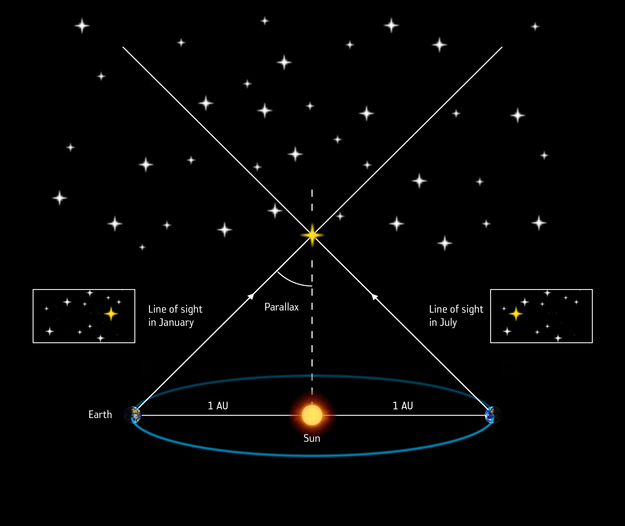The positions of stars in the sky have been known and measured for millennia, but the first measure of the distance of a star (besides the Sun) from Earth is less than 200 years old! This incredible endeavor was finally accomplished in 1838 by Friedrich Bessel, when he determined the distance of 61 Cygni: the star measured to be 10.3 ly away from the Sun (100.000.000.000.000 km, or one hundred thousand billion km).
He determined the distance from the measure of the parallax of the star. But what is the Parallax? If we observe a star twice, six months apart, we observe it from two different positions, because the Earth has moved in its orbit around the Sun. If the star is close enough, it seems to have moved across the sky, relative to reference stars in the background (farther away, they did not move). This is due to the change in perspective, since the Earth is on opposite sides of the Sun. This apparent motion of the star is called parallax and can be easily linked to its distance.

To obtain this measure, Bessel accumulated data for three stars, repeatedly measuring their positions each night for 90 nights: the final value of the annual parallax for 61 Cygni, of 0.3136 seconds of arc, corresponds to a distance of 10.3 ly. Today we know that he was almost right: with his instrument, the heliometer, the distance he measured (the angle of parallax) was off by 10% from what we believe today to be the correct distance, 11.4 ly.
Distances are a fundamental measure in astronomy: with distances, astronomers can estimate the physical parameters of the stars, such as intrinsic luminosity and size, so that they can finally better understand the properties of the objects. But with his measure, and the use of the parallax method, Bessel, and other pioneers such as Friedrich von Struve and Thomas James Henderson, could correctly place the first few stars of our Galaxy at their proper position in the “Universe”.
Since then, the parallaxes of many more stars have measured. At the beginning of the century, a few hundred stars were measured by Jacobus Kapteyn, and as late as 1995 a catalog of 8000 stars was published by William van Altena. But the Earth’s atmosphere provides a serious limitation to the precision that can be obtained from the ground. For a major step in precision and numbers, satellites are needed. In 1997, the catalog based on data collected by the ESA’s Hipparcos mission (1989-1993) contained more than 100000 stars, with parallaxes measured to a precision of 0.01 seconds of arc. Today the data collected by the Gaia Satellite (Global Astrometric Interferometer for Astrophysics, launched by ESA in 2013) provide an outstanding 3-D map of the Milky Way galaxy, based on the positions and distances of more than 1.3 billion stars, measured with a precision of 0.00001 seconds of arc for the brightest stars observed.
Credits immagine: By ESA/ATG medialab
